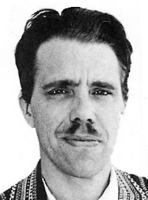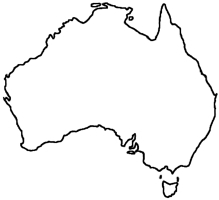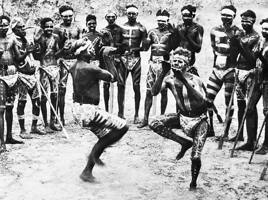
|
The Society of Folk Dance Historians (SFDH)
Australian Aborigine Dancing
[
Home |
About |
Encyclopedia | CLICK AN IMAGE TO ENLARGE |

|
 The traditional songs, dances, and music of the Australian aborigines are all owned by the clans living on any particular area of the land.
The traditional songs, dances, and music of the Australian aborigines are all owned by the clans living on any particular area of the land.
As in everything else in the life of the native Australians, these were created by the Heroes of the Dreamtime, and given to the separate clans to hold in a sacred, perpetual trust – to remember, to perform, and to hand down, generation by generation over the centuries, orally for there was no form of written communication.
Some dances are public-sacred; others are secret-sacred. As the Dreamtime is a Past, with no beginning and no end, things can be retrieved from it by dreaming. A dance in the public-sacred domain may be dreamed by either men or women, and the person who dreams it, along with closest relations, are considered the owners of that dance. It would be absolutely unthinkable for anyone else to perform such a dance or sing that song, without express deliberations with, and permission of the owners.
Aborigine reservations are found over much of Australia, but especially in Northern Territory, Queensland, Western Australia and the adjacent islands, Melville, Bathurst, and Groote Eyland. Dance and music styles vary from place to place, although all have a common heritage in Dreamtime and certain similar (to European eyes) style and movements. The songs and dances of eastern Arnhem Land, for example, are performed to celebrate a youth's initiation into manhood; to pay respect to a honored leader if death seems imminent and thus ensure the return of his spirit to Dreamtime after death. A well-documented example of the death/burial ceremonies is that of the Tiwi who live on Melville Island off the coast of Arnhem Land. This is the "Pukamuni ritual" described in the National Geographic Magazine, March 1956. Everything connected with the ritual is dictated by custom, including the carving and painting of the poles that represent various members of the family, present and past.
 Readers who attended the performances by the touring Aboriginal Artists of Australia at UCLA will remember that some of the dances were exceedingly short. This is not unusual. You will have noted too, the long stopless, end-blown pipes or tubes used to produce the music – although to our ears, it certainly lacked melody. These were the didgeridoo, and most of the Australian tribes seem to have them, although not originally known in the land of the Tiwi. Elspeth Huxley writes that the sound is something of a cross between "gibbet-yarra" (any instrument of public execution from Yarra) and the roar of a bull. They have those too – bull-roarers, as well as clapping sticks, shell rattles, and a form of drum stuffed with feathers. All of these put together – the dancing, the sounds from the instruments, and the song chants along with other ritual (including the decorative) – form a "corroboree" (a dance ceremony which may take the form of a sacred ritual or an informal gathering). This original aboriginal word is so descriptive of a good time that it has been taken into the Australian every-day language to indicate a big festive occasion.
Readers who attended the performances by the touring Aboriginal Artists of Australia at UCLA will remember that some of the dances were exceedingly short. This is not unusual. You will have noted too, the long stopless, end-blown pipes or tubes used to produce the music – although to our ears, it certainly lacked melody. These were the didgeridoo, and most of the Australian tribes seem to have them, although not originally known in the land of the Tiwi. Elspeth Huxley writes that the sound is something of a cross between "gibbet-yarra" (any instrument of public execution from Yarra) and the roar of a bull. They have those too – bull-roarers, as well as clapping sticks, shell rattles, and a form of drum stuffed with feathers. All of these put together – the dancing, the sounds from the instruments, and the song chants along with other ritual (including the decorative) – form a "corroboree" (a dance ceremony which may take the form of a sacred ritual or an informal gathering). This original aboriginal word is so descriptive of a good time that it has been taken into the Australian every-day language to indicate a big festive occasion.
In the deserts, among the peoples who inhabit those vast areas of Western Australia, the Victoria desert of South Australia, Northern Territory (southern part, surrounding the "Alice" or Alice Springs) – the ceremonies involve a re-creation over many hours, sacred designs and totems used by the Heroes of the Dreamtime. After this re-creation is completed, the certain ceremonial dances or acts are performed last, perhaps only a minute or two, and then diffused into the landscape, for the eternal benefit of life.
Dances also represent the acts of surviving in everyday life. There are fish-spearing dances and hunt dances. Prominent also are dances telling of the flight of birds – the seagull and the white cockatoo – and animals such as the kangaroo. Men do much more dancing than women – in fact, some dances are absolutely forbidden to women. The aborigine dancers are a parody. John Gunther relays a story about a group of anthropologists who were watching a performance by a circle of dancers at a corroboree, in which a solo man danced from dancer to dancer around the outer circle, scrutinizing faces, and making motions as though writing notes on a sketch pad. Suddenly, embarrassed, they realized that the dance group was making fun of the anthropologists themselves and imitating the actions of their own behavior when interviewing members of the tribe at a recently previous occasion.
DOCUMENT
- Australia, a country.
Printed in Folk Dance Scene, February 1982.
This page © 2018 by Ron Houston.
Please do not copy any part of this page without including this copyright notice.
Please do not copy small portions out of context.
Please do not copy large portions without permission from Ron Houston.